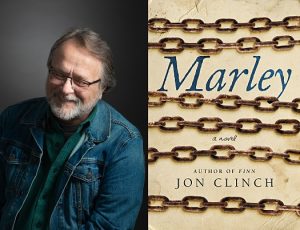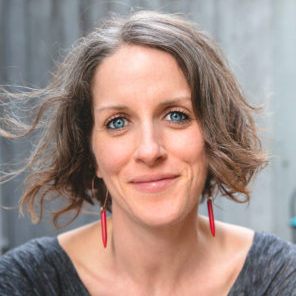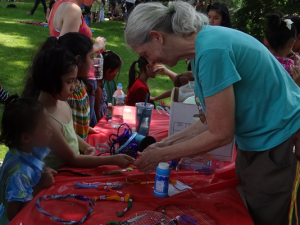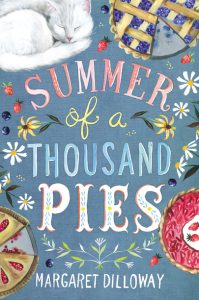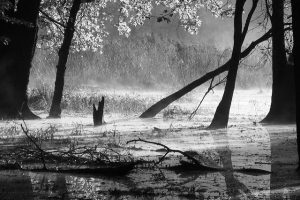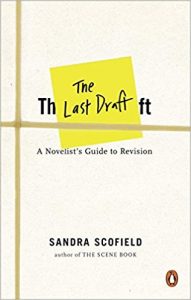Interviews
Today I’d like to return to an author I’ve spotlighted before: Jon Clinch, whose latest novel MARLEY hit the shelves earlier this month. I’ve known Jon for a dozen years or more, and have always admired his dedication, his work ethic, and his damn good writing.
Jon’s “serious author street cred” is undeniable, with his debut novel FINN earning him acclaim from the Washington Post, the Chicago Tribune, the Christian Science Monitor, and the American Library Association, among others. Oprah’s “O” magazine praised his next novel, KINGS OF THE EARTH, as “masterful and compassionate.”
With MARLEY, Jon offers us a reimagining of the characters made famous in Charles Dickens’s A CHRISTMAS CAROL, exploring the complex and ultimately toxic relationship between Ebenezer Scrooge and Jacob Marley. Make no mistake: This is not a retelling of the Dickens classic; rather, it sets the stage and helps us understand what made Ebenezer such a, well, Scrooge. And we finally learn why Marley’s ghost kept rattling those infernal chains.
To get a sense of the reading experience that awaits within the pages of MARLEY, check out this to-die-for New York Times book review, in which reviewer Simon Callow praises how Jon “endows Dickens’s snapshots with a three-dimensional, often alarming, life,” and concludes that “Clinch has done something remarkable in ‘Marley,’ not merely offering a parergon to Dickens’s little masterpiece, imagining the soil out of which the action of ‘A Christmas Carol’ grows, but creating a free-standing dystopian universe.”
(No, I’m not jealous of that NYT review. Not at all.)
Ahem. Back to Jon. He was gracious enough to take a break from the whirlwind of activities and obligations that accompany a major book launch to answer a few questions for our WU audience. Read on for a thoughtful glimpse into the mind of a master storyteller.
Keith: MARLEY marks your second time developing a character from a major novel written over a century ago, in each case fleshing out what was previously a supporting character into a memorable and compelling protagonist. When working with such well-known source material, how do you make it a springboard for creativity, rather than a straightjacket?
Jon: The key, for me, is always to take the novelist’s word as gospel—and therefore to work within his world as if it’s a real place occupied by real people. The first requirement, then, is to study the original work in a particular kind of way.
In an essay I wrote for a book of fresh looks at HUCKLEBERRY FINN, I described the process as “a reading of the original that was both close and expansive, an approach that instead of being critical or scholarly was engaged and sympathetic. It would be the willful act of a reader prepared to enter the author’s world via both the text on the page and the text left unwritten. Such a reading of HUCKLEBERRY FINN could not focus directly on Twain’s technique or methods. On the contrary: my intent was to be captivated only by the narrative, immersed completely in Huck’s story as if it had actually taken place and […]
Read MoreElizabeth’s marketing at work.
For my final installment of my Author Up Close series in 2019, I’m sharing a Q&A with Elizabeth Bell. Elizabeth and I e-met after both finaling in a writing award competition. Elizabeth is a craft genius—no surprise there; she has an MFA from George Mason University and works in the school’s library. When I caught up with her she was launching her novel, Necessary Sins, a James Jones First Novel Fellowship finalist. Her 26-year journey to publishing is fascinating, and our Q&A provides an honest look at the sometimes tumultuous road to publishing and how that road makes it even more important to define success on your own terms.
GW: You’ve got an interesting backstory when it comes to writing Necessary Sins, including how long you spent working on it. Will you share what inspired you to write about this particular subject?
DB: When I was eight years old, I visited Charleston, South Carolina. I fell in love with its gardens and architecture and wanted to set a story there. As an adolescent, I devoured Colleen McCullough’s The Thorn Birds, John Jakes’s North and South, and Alex Haley’s Roots. I wanted to write a saga on that scale, something with multiple settings that would follow characters across decades. Those stories are great escapism and drama, but they also taught me about history and place.
The central family in my saga, the Lazares, is multiracial and “passing.” This was partially about secrets—family sagas always revolve around those—and partially about history, getting at the heart of the contradictions that are the American Dream. But the very first seed of the Lazares’ racial makeup came from my mother. She read an early draft and told me Caucasian people don’t have black hair; it would have to be dark brown. But my Lazares had black hair; I just knew it! Caucasian people do have black hair—the Welsh, for instance—but somehow the “problem” of black hair simmered in the back of my mind. I was puzzling out David’s (one of the main characters) personality, what made him reluctant to trust and reveal his true self, as well as why his uncle Joseph might choose to become a celibate priest. Joseph is very pious, but as a priest, he’s also hiding in plain sight. My characters are products of their time, but I wanted them to resist racism. What might make them view the world differently than the slaveholders around them and work for justice? My answers to these questions coalesced into the Lazare family having African ancestry.
It’s taken me a quarter-century of research and revision to become a wise enough person and good enough writer to tell this story.
GW: You went to great lengths to authentically portray characters with African ancestry. Will you share some of the things you did to help with that?
Read More
I’ve invited Zoe Quinton to join me for this month’s post. She’s not just the brilliant daughter of New York Times bestselling author Laurie R. King, she’s also Laurie’s agent and publicist. In her “spare time,” Zoe is an editor and a consultant on the publishing business, including concept development and marketing.
For this post, I wanted to focus on developmental editing, a service both Zoe and I provide. It’s distinguished from copy editing in several significant ways. Whereas the latter deals with issues such as grammar, usage, syntax, punctuation, and fact-checking, developmental editing deals with more global story issues: characterization, theme, plot, pacing, continuity, and so on.
David: Why not tell our readers a little bit about your background and how you got into developmental editing.
Zoe: Well, for me that’s a little like saying how did you get into breathing. I can’t honestly remember a time that books weren’t a large part of my life, a constant companion, a source of escape and wonder. I remember even as a child narrating the mundane events of my daily life as if they were written down in a book. I have always eaten, breathed, drank words.
I can’t honestly remember a time that books weren’t a large part of my life
It helped that my parents also both lived a life of the mind, my dad as a religious studies professor at our local university and my mom first as an academic and then as an author. I’ve been accompanying her to publishing events since I was thirteen years old, so words and reading are literally part of my blood.
I myself am a recovering academic, as I got a master’s degree in international history from the London School of Economics when I was 25. I loved the research and the—no surprise—storytelling of history, and the training I received was priceless: I learned to think and write and argue, how to shape words into a weapon or a salve, how to choose just the right fact to prove my point and let the others fall by the wayside.
A few years later, I started working as my mother’s publicist and later agent, and I soon leveraged my decades of experience by her side into a consulting business helping authors write, edit, and sell their books. My favorite part of my work is truly the editing, where I can get lost in the words and the flow of the story for hours at a time. In a way my life has come full circle—I’m still the girl with her nose stuck in a book, but now I’m getting paid for it.
David, I’d like to know what your favorite part of editing is. Do you, like me, stare into space while working on a project trying to figure out how to make that tricky plot point work? Or is it when a client really gets it and runs with your advice in just the right way?
David: Since I came to developmental editing by way of teaching, I can readily say that the best part of editing is when a client gets back to me saying they understand what I was trying to convey about their work and have launched […]
Read MoreAuthor Anne O’Brien making friendship bracelets.
In this week’s Author Up Close, I interview Anne O’Brien Carelli, author of adult nonfiction, the middle-grade book Skylark and Wallcreeper, and the picture book Amina’s New Friends. She’s been a friend and mentor since we met at our first Writer Unboxed conference. Anne is the owner of a leadership training business, and she has taught me invaluable lessons about managing the craft and business sides of being a writer. Her advice will be especially helpful to anyone writing and querying middle-grade or YA fiction, and she’s a great example of using the skills you’ve learned in previous careers in your career as a writer.
GW: How did you find your agent and land your publishing deal?
AOBC: I had published two nonfiction adult books and self-published a picture book, but the children’s traditional publishing world was new to me. I soon discovered that writers who want to publish a children’s book need to have perseverance, blind optimism, a desire to hone the craft, and a belief in serendipity. It also helps to pay close attention to what is published in your genre.
I found my agent by chance. As I was researching an editor I admired at a conference, I came across a description of her colleague, who looked like the perfect match for my middle-grade book, Skylark and Wallcreeper. I had rewritten my query a million times, but tried again.
I think it’s really important to investigate what agents like to read, what they are looking for, and what types of books they have represented in the past. You can learn a lot of this information by attending conferences and signing up for short consultations with individual editors and agents.
As for landing the publishing deal? I give my agent all of the credit for that. She also looked for the right match and Little Bee Books has been a wonderful home for my book.
GW: Why did you decide to write middle-grade fiction, and why this subject matter?
AOBC: There was never any doubt that I would eventually write middle-grade fiction. The picture book was written because I have volunteered with refugee children for many years and saw that the story about a refugee girl’s first day in an American school was desperately needed. The textbooks I published were related to my work in gender equity and leadership. But many eons ago I taught sixth grade and social studies, and middle grade is my favorite age group (ages 8-12). Those kids are just on the cusp of figuring out who they are, and are developing independence and coping skills. middle-grade books, especially in the last two or three years, address a number of tough issues that kids are facing today. But every middle-grade book has hope at the end, and that appeals to me.
Read MoreAuthor Roger Johns
So far in my Author Up Close series, you’ve met Fiona Zedde, an author whose hybrid approach to publishing has allowed her to live and work anywhere in the world and Linda Seed, a self-publishing success story who made more from a single ad placement than many authors make in their entire careers.
Today I’m sharing my Q&A with Roger Johns, whose debut novel, Dark River Rising, was eleven years in the making and who is one of the smartest and hardest working authors I know. Roger received an offer from a publisher before he even had an agent, and today he shares wonderful insights into balancing the craft and business sides of writing, the importance of being honest with yourself about your work, and the five things he did that helped his manuscript—and that may help yours—stand out among hundreds of others.
GW: I’m a fan of origin stories, and though the term is usually only used to describe superheroes, I love to use the term with published authors. What’s your writer-to-published-author origin story for your debut novel, Dark River Rising?
RJ: The idea for my first book came to me, out of the blue, in the spring of 2006. Even though I was focused on other matters back then, I toyed with the idea, made occasional notes, and periodically announced to my wife that I was writing a novel. But, it wasn’t until I realized that an idea for a book was not the same as a plot that writing the book seemed possible. This was the first of several critical realizations.
In the fall of 2008, I met Atlanta author, David Fulmer. With some elbowing from my wife, I let it slip that I had this idea for a book but I didn’t know what to do with it. The winter iteration of David’s writing workshop for beginners was starting soon, so I signed up. I learned a lot, but I still had problems.
Not until I realized the book should be about how a person experienced a world shaped by my idea, and not about the idea itself, did the path forward open up. This was the critical turning point. Still, I never got past page seventy-five or eighty.
In desperation, I changed my male main character’s age, job, history, and mission, but nothing worked. Then, some of that little-voice-in-the-back-of-my-head magic told me to audition a woman for the lead role. Immediately, I realized: (1) I should do this, and (2) I have no idea how to do this.
In the fall of 2013, I joined my first critique group. Over the next eighteen months, I joined and left four groups, learning from each how to solve a specific problem. I also completed a first draft, finished several rewrites, made my original idea the fundamental driver of the story, and learned to write a female character with a degree of authenticity.
All the while, I was cold-querying agents and attending conferences, trying to sell the book. In May 2015, an editor at St. Martin’s Press, who had critiqued my first 20 pages at a conference, asked to see the whole book. In June, after using her feedback as a […]
Read MoreToday we celebrate the April 16 release of Margaret Dilloway’s new novel, Summer of a Thousand Pies.
Thank you for joining us to answer a few questions regarding your novel, Margaret!
A descendant of samurai and Irish-American coal miners, Margaret Dilloway is the internationally published author of women’s fiction, middle grade fantasy, and middle grade contemporary novels. THE CARE AND HANDLING OF ROSES WITH THORNS won the American Library Association’s Literary Tastes Award for Best Women’s Fiction. HOW TO BE AN AMERICAN HOUSEWIFE was a John Gardner Fiction Award finalist.
MOMOTARO: XANDER AND THE LOST ISLAND OF MONSTERS, published by Disney-Hyperion, won the ALA’s Asian/Pacific Librarians Honor Award for Middle Grade Literature. Her novels have been selected for Indie Next lists and as choices for Book of the Month club, Target, and Costco.
Dilloway lectures and conducts creative writing workshops for both children and adults. She also enjoys performing improv, baking, volunteering, and hiking. She lives in San Diego with her family.
“Fans of Anne of Green Gables will find a satisfying story and another heroine to cheer on…. Sweet as pie.” (Kirkus Reviews)
Q1: What’s the premise of your new book?
After her father goes to jail, 12-year-old Cady Bennett goes to live with Aunt Shell in the mountains of San Diego, whom she’s never met before. There she gradually opens up, makes friends, becomes a Great British Bake-Off fan, and learns how to bake.
Q2: What would you like people to know about the story itself?
Read MoreCambria, California
Welcome to the second installment of Author Up Close, the series that explores several authors’ paths to publishing. If you missed the first in the series, a Q&A with author Fiona Zedde, you can read it here.
There are probably as many articles about the perils of self-publishing as there are about the “fall” of traditional publishing. Most of these articles lack nuance and are more concerned with promoting a perceived “right” way to publish while disparaging the “wrong” way. In reality, choosing a publishing path is a very personal decision, and what’s right for one might not be right for others.
Today’s featured author, Linda Seed, obviously made the right choice for herself and her career when she decided to self-publish. Linda is a contemporary romance writer, a Writer Unboxed Conference alum, and a friend. We’re in a few online communities together, and over the years I’ve watched her career grow from an author who, in her words, “made enough to buy a coffee” to one who now makes a living from her books.
In a sea of self-published authors, Linda stands out because of her excellent writing, commitment to quality, and strong work ethic. And as you’ll see from our Q&A, those things probably had a hand in getting Barnes & Noble’s attention at just the right time in her career.
GW: What do you write and how many books have you published?
LS: I write small-town contemporary romance, with all of my books set on California’s Central Coast. I’ve published nine books so far.
GW: You’re doing what a lot of other authors wish they could be doing right now: making a full-time income from your writing. When you started writing, had this been your goal? If not, when and what changed that?
LS: Honestly, when I started, I didn’t expect to make any money at all. It was more of a bucket list thing—I wanted to have a published book out there. For me, the day I uploaded my first book onto Amazon, my goal was met. Anything else was just a bonus.
Things changed eleven months later, in September 2016. I had two more books out by then, and I had just made my first book free. I went onto Facebook one morning to find a bunch of notifications from friends congratulating me. I learned that Barnes & Noble had featured my first book as their Free Fridays pick. My book was all over their social media, on their website—it was crazy. That drove the sales of my other books, and overnight I was making ten times more money than I had been. That was when I thought, okay, I might be able to make this into a viable business. I still have no idea why they chose my book, but that was really a turning point for me.
Read MorePhoto by Marcos Luiz Photograph on Unsplash
Though you may not know it by the prevalence of clickbait headlines sounding the death knell about author careers, successful authors are out there. Lots of them. And I’m not just talking about the ones who top the bestseller lists week after week. I’m talking about the authors whose names you may have never heard, who are quietly writing and earning income from their books.
And while there is no formula for becoming a successful author, or even a consensus about what defines “success,” there is much that can be learned from studying authors who are already where we hope to be one day. I’m fortunate to know several of these authors. I’ve had the benefit of their wisdom and expertise for years and wanted to share some of that wisdom with you. So this year, in my posts for Writer Unboxed, I’ll be sharing Q&A’s from authors I think we can all learn from.
My series, Author Up Close, will include Q&A’s with two of Writer Unboxed’s own: Anne O’ Brien Carelli, whose middle-grade novel was published by Little Bee in 2018; and Linda Seed, a contemporary romance author who had so much success self-publishing, she was able to leave her 9-5 to write full time. The series will also include interviews with Roger Johns, a traditionally published author who found himself in the enviable position of having to find an agent after being offered a publishing deal, and Vanessa Riley, a Ph.D. in mechanical engineering who writes multi-cultural Regency and historical romances in an industry that (falsely) believed there wouldn’t be a large enough audience for her work.
Author Up Close begins with a Q&A with Fiona Zedde. Fiona is the author of several novellas and novels including the Lambda Literary Award finalist Bliss. Her novel, Dangerous Pleasures, won the About.com Readers’ Choice Award for Best Lesbian Novel or Memoir of 2012. Fiona lives a location-independent lifestyle, traveling and sometimes living abroad for months at a time. As you’ll discover from our Q&A, her ability to adapt to changes in the industry has been key to her success as an author.
GW: You’re what the publishing industry considers a “hybrid author.” Was this an intentional strategy you adopted when you first launched your professional writing career or is this something that evolved?
Read MoreSeveral years ago, I got into an argument with a friend who tried to convince me climate change was a hoax, based, in part, on his reading of Michael Crichton’s novel State of Fear, a 2004 thriller with a climate change denier as the main character. My friend tried to make a case against climate science based on a work of fiction Publishers Weekly called “half anti-global warming screed and half adventure yarn.”
I think that was the moment I realized how powerful fiction can be in shaping beliefs and attitudes. Fiction invites us to see through someone else’s eyes and live convincingly in their world. The emotions writers invoke can change our minds and hearts.
Fiction has power. How we chose to wield that power matters.
Although the concept of writing about climate change isn’t new, Cli-Fi novels have been garnering more attention in recent years. It’s no wonder, given 2018’s Bomb Cyclones, hurricanes Florence and Michael, and devastating wildfires, as well as the quieter stories of diminishing water resources, species migration, and agricultural disruption around the world.
Considering the dire future we face, I started to wonder if authors tackling stories that engage climate change carry an added burden of responsibility. Does the science have to be real? Do the characters and story matter more than the message? Or vice versa?
To find some answers, I reached out to author Omar El Akkad, whose 2018 debut novel American War (Knopf) takes place in the late twenty-first century in the wake of a second US civil war. Coastlines have shifted as a result of sea level rise. Fossil fuels have been outlawed. Reading American War felt eerily like peeking at US history that just hasn’t happened yet. El Akkad is an award-winning Egyptian-Canadian journalist currently living in Oregon. American War won the 2018 Ken Kesey Award and the 2018 Pacific Northwest Book Award.
Julie Carrick Dalton: Omar, congratulations on the success of American War, and thank you for joining us here on Writer Unboxed. When you first started drafting American War, were you more motivated by the characters, the story, or a message you wanted to relate?
Omar El Akkad: I started with a thesis statement of sorts – that suffering, and our reaction to suffering, is universal. I wanted to write about the nature of revenge, the ways in which damage begets damage. What I had was something that, to be honest, was much more of a foundation for something like an essay. It wasn’t until I started building the world of American War that the more novelistic aspects of the project began to come together. Then one day, out of nowhere, this image of a young girl pouring honey into the knots of the wood on her front porch came to me. That girl was Sarat Chestnut, and as soon as she arrived, everything else took a backseat. Quickly American War became her story, first and foremost, and stayed that way until the end.
JCD: Many climate stories are told in silos. They address a specific impact of rising seas, or flood risk in a particular region, political unrest, the fate of fossil fuels, extinctions, etc. In American War, you engage race, political borders, geopolitics, issues of identity, […]
Read MoreFlickr Creative Commons: Second-Half Travels
The book business is divided between two divergent yet synergistic entities: art and commerce. As authors, our stories are imaginatively composed, subjectively appreciated, and diversely interpreted. These qualities don’t particularly abide by Wall Street rules, but to make writing a vocation, the work cannot exist in a void. Whether we like it or not, there is a parallel corporate track to literature that has existed long before any of us. It’s not to be feared but to be embraced as part of the organic ebb and flow of literary dissemination. Through the ages, the business of publishing the written word has proven itself a fundamental part of every progressive society, and it requires expert tradespeople. Enter the heroic bookseller.
The bookseller is the fulcrum on which the reader-author/buyer-seller/consumer-creator relationship functions effectively. Understanding how we, as writers, can aid their work only improves the dynamics between us and helps the literary community flourish further.
So in an effort to learn more, I’ve invited one of my favorite people to Writer Unboxed. It’s with great pleasure that I introduce Beth Seufer Buss, the brilliant community outreach manager of Bookmarks in North Carolina.
Welcome Beth! Let’s chat about being a bookseller.
What’s your role and what do you enjoy most about it?
Beth Seufer Buss: There are many incredible things about my job, but one of the things I treasure the most is helping readers connect with books and authors, which is part of the Bookmarks’ nonprofit mission. Being able to help readers find themselves in books, learn about a new culture, or escape to a new adventure is a privilege and something I hope I never take for granted.
This summer we had a mother and son (let’s call him Tony) visit Bookmarks. Tony didn’t seem thrilled to be there and told me flat out he didn’t like reading. The one book he came to the store to get wasn’t due to be published until later that month, only adding to his frustration. We talked about different books, and he reluctantly agreed to try ARU SHAH AND THE END OF TIME by Roshani Chokshi. Fast forward to two weeks later, when Tony and his mother returned to the bookstore — he was radiant! He wanted to tell us how much he loved Aru, look for more books, and even had his picture taken in front of the store. They returned for our one-year birthday party and our Scholastic Summer Reading Road Trip event, and to quote Tony’s mom, “we’ve created a monster.” Those moments are absolutely magical to me!
How do you feel about the way technology is affecting book readership and book purchasing?
Beth Seufer Buss: One of the things technology has done is make it far easier for people to connect with others. Social media allows readers to connect with and follow their favorite authors, stay on top of big news from the book industry, discover new and diverse authors, and interact with other readers. Podcasts are an increasingly great way to keep up with book news and reviews, genres, analysis, writing, and more. It’s a wonderful time to be a reader!
Technology is also responsible for giving us books in new formats, particularly […]
Read MoreIn the publication world, there’s a tremendous amount of focus on the publication date as THE time for publicity and promotion. I’ve seen authors throw up their hands the week after publication, when media interest is just starting to trickle in, and say, “I guess we struck out.”
As I’ve mentioned here before, book promotion and publicity take time. It can often take months for an article or review to appear. But even though it’s ideal to get promotion efforts started before the big on-sale day, the sky’s the limit as far as what can be done, and what can happen, even long after that day.
My friend and literary idol Anjali Mitter Duva is a glowing example. Her debut novel, Faint Promise of Rain, released in October of 2014. Since then, she has devoted herself tirelessly to promoting it via traditional media, social media, public speaking engagements (including the occasional dance performance related to the book’s plot) and much more. Last year, her efforts led to the fulfillment of a dream: a foreign rights deal with French publisher Editions Tallandier. The French edition, Adhira, fille de la pluie, released in France (where Anjali grew up) this past May – almost 4 years after the U.S. publication. Anjali’s deep commitment to long-term promotion played an important role in this wonderful turn of events.
What did she do? How did she do it? I’m thrilled to have Anjali join us today to talk about her incredible journey, and share a number of extremely handy and insightful tips: One of my favorites: “know that you’re in it for the long haul and make plans that are slow, steady and sustainable.”
Welcome, Anjali!
SB: From the very start, you had a clear vision of what you wanted for Faint Promise of Rain. Can you share that with us?
AMD: When I started to write Faint Promise of Rain, way back in a previous era, I already knew I was in it for the long haul. You see, I planned from the start to write a set of four related but free-standing books, all historical novels with dance and India at their center, yet all set at different times and contexts in history. FPR was to be the first. I think some of this long-term planning comes from my background as an urban planner working on infrastructure projects: very long projects with frequent cost overruns and schedule changes! This long-term vision is what set the tone and pace for my promotion efforts: slow, steady, sustainable. My idea was to build a loyal, strong readership and following, because I knew (at least, I hoped, and still do) that people who enjoyed my first book would likely enjoy my next three as well. But these are historical novels that take, for me at least, years to research and write. So my approach had to be one I could sustain–financially, logistically, energy-wise–over time. Years, if not decades. Five […]
Read MoreSarah McCoy with Sandra Scofield
I first met Sandra Scofield over ten years ago. A visiting professor to my MFA program, Sandra was lauded for her unparalleled storytelling and a National Book Award Finalist (Beyond Deserving) as proof. To work with her, master students had to submit their stories and be accepted for one-on-one workshops. I had the great honor of being selected. I was working on my thesis, which would go on to be my first novel The Time It Snowed In Puerto Rico. At the time, however, I came to Sandra with only a handful of short stories set in 1960s Puerto Rico. She was loving but brutally honest in her critique. Her aim was not to foster her students’ egos. No participation trophies in Sandra’s satchel. The ultimate good of the story was paramount.
At the java shop that my fellow MFA-ers gathered, some lamented the criticism of our straightforward Montana mentor. But I’ve never been one for mollycoddling—giving or receiving. I took to the fierce twinkle in her editorial eye, and we forged a friendship through common understanding that it isn’t the author that earns praise or censure but the writing. It’s been over a decade now. I’ve lost touch with many of my MFA colleagues but my devotion to Sandra has only rooted deeper.
She came to visit me in Chicago last year. We had tea at the local indie bookstore, swapped stories, photos, laughs and books, of course. She shared her new novel Swim: Stories of the Sixties with me. The narrative mastery left me wonderstruck. So when she sent me the advanced copy of her new craft book (releasing December 5, 2017), I nearly tackled the mailman on delivery. St. Nick came early! And I was not disappointed.
The Last Draft is an invaluable guide to a novelists’ revision process. All the lessons I learned from Sandra for the last ten years are bow-tied and bound into this compelling resource. Author guru Janet Burroway (Writing Fiction) calls this “a needed book…” And I have every confidence it will be part of the creative writing canon.
So it is with great pleasure that I welcome Sandra to share her wisdoms with our Writer Unboxed community.
Read MoreSeeing your book on the silver screen: it’s a universal dream, one that nearly every novelist I’ve worked with has confided that they harbor. Barely a day goes by when an author does not ask me whether I have any Hollywood connections who could help them get a foot in the door.
Sure, I have some loose contacts in “The Industry.” A screenplay writer here, a director there, a financial VP. But that doesn’t mean I can slip someone a manuscript and open doors. Far from it. In fact, how and why certain books get made into movies is a complete mystery to me — as it is to so many others.
Which is why, when I recently met the co-founder and president of production and acquisitions at an L.A. production company associated with Showtime Networks, CBS Films and Netflix over a conversation about a book he was considering making into a movie, I asked if he’d talk me through the process of how, exactly, novels are discovered by the film industry.
I’m delighted that he’s agreed to do so “on the air” here at Writer Unboxed. A warm welcome to Brett Tomberlin of Imagination Design Works (IDW).
Q: In general, where do the ideas for the movies you decide to produce come from?
BT: In most cases scripts come to us though attorneys or agents. Since there are so many lawsuits, you have to be super careful in Hollywood to only take material from an attorney, a manager or an agent with all the legal bases in place.
Sometimes people come in without a script but with a concept. These are usually people we know and have worked with. We know their track record and their capabilities, so we’ll talk to them.
And we do get people coming to us with books. As long as the book is published – whether traditionally or self-published – we can look at it because its publication is a time stamp showing it’s been released out into the public. Legally, this works for us.
Q: About how many of the ideas you get come from books?
Read MoreA couple years ago in Tucson, I had the pleasure of sitting down to supper with a remarkable handful of author friends: Jean Kwok, Edan Lepucki, and Scott Turrow. We’d traveled across the miles for a book festival and had spent the day at our various speaking events. All were exhausted, slightly sweaty, and hungry, which lent both a familial and illusive vibe to our gathering.
The restaurant was western themed: colored lights had been strung between red pepper skeins; the walls were a rainbow of Mexican tiles; a giant Long Horn skull hung over the entrance. The building was a local icon and had once been the town’s signature hotel. We sat inside away from the patio crowd despite our knees banging into one another under the table. Intimate was the word we whispered. That didn’t bother us. Our waitress had an Annie Oakley drawl and was quick and skilled on the pours. Mariachi music played faintly from a jukebox.
I couldn’t tell you what we ate or drank, though I know we did because our table was full of empty dishes in the photos. While substantial, the meal wasn’t what filled us. The company did. For hours, we talked of our writing, our business, our loved ones, those we admire, and our dreams for the future. As storytellers, it’s important to listen, too. To stop supplying the narratives and allow our own creative cup to be replenished by others. I loved hearing how each friend came to write and publish and be; what they struggled with then and now; and most importantly, the path they saw ahead.
It’s an incredible gift for a writer to find a group of peers she both admires and trusts. I’d go so far as to say that it is an essential of being a progressive author— an author in progress—the art of communal learning.
Scott and Jean shared a piece of cake for dessert. I ate all the whipped cream off Edan’s chocolate mousse. We drank coffee and laughed until the place was about to close up. Scott, being the gentleman that he is, picked up the check, and we left. Writing quills blown to the four winds.
Since then, each of us has given birth to a new book. (In Edan’s case, a book and a baby!) So I thought this might be the perfect opportunity to get the gang back together. In spirit, I’m bumping elbows with Edan and spooning off her plate. Jean and Scott are across the table kicking our shins and lifting glasses. That’s the beauty of our craft and friendship: all we need do is write, and we are together again.
So pull up a chair, friends, the three questions on the virtual table are:
1) What did your first book teach you?
2) What is your current book teaching you?
3) What do you hope to have perfected by the end of your career?
Q1: What did your first book teach you?
JK: I was completely clueless when my debut novel took off. I was running behind, trying to figure things out like: how to tweet and how to unfreeze my face when someone took a photo of me. The public aspect of being an […]
Read More
